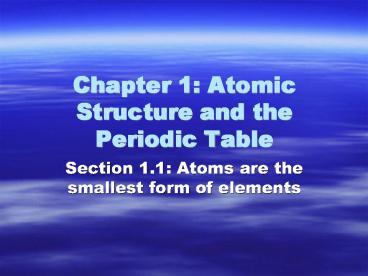Chapter 1: Atomic Structure and the Periodic Table - PowerPoint PPT Presentation
1 / 16
Title:
Chapter 1: Atomic Structure and the Periodic Table
Description:
**THE _____ HAS AN OVERALL POSITIVE CHARGE** The Structure of an Atom Electron A _____ charged particle located outside an atom s nucleus. An electron is ... – PowerPoint PPT presentation
Number of Views:157
Avg rating:3.0/5.0
Title: Chapter 1: Atomic Structure and the Periodic Table
1
Chapter 1 Atomic Structure and the Periodic Table
- Section 1.1 Atoms are the smallest form of
elements
2
All matter is made of atoms
- Are all substances we touch the same?
- Example A book is made of a different _________
then air. - First it was thought everything was made of
- Air, ______, fire, and earth
- Today chemists know about ____ basic substances,
or _________, account for everything we see or
touch. - Element is related to the word elementary which
means ______
3
Types of Atoms in Earths Crust and Living Things
4
Types of Atoms in Earths Crust and Living Things
5
Names and Symbols of Elements
- Where do these names come from?
- People, ______, and Greek words
- Symbols
- First Letter of Its Name
- Hydrogen ___
- Sulfur ___
- Carbon ___
- First Letter Plus One More Letter
- Aluminum ____
- Platinum ____
- Zinc ____
6
Names and Symbols of Elements (cont.)
- Some symbol names are less obvious.
- Symbols from Latin Name
- Gold ____
- Lead ____
- Iron ____
- Copper ____
7
Each Element is Made of Different Atoms
- Dalton was the first to propose that each
________ is made of tiny particles called ______. - Atoms are made of even smaller particles
- ________
- ________
- ________
8
The Atomic Model
9
The Structure of an Atom
- Proton
- A __________ charged particle located in an
atoms nucleus. - Neutron
- A particle that has __________ charge and is
located in an atoms nucleus. - Nucleus
- The central region of an atom where most of the
atoms mass is found in ________________. - THE ___________ HAS AN OVERALL
POSITIVE CHARGE
10
The Structure of an Atom
- Electron
- A ___________ charged particle located outside an
atoms nucleus. - An electron is about ______ times smaller than
either a proton or neutron. - The ______________ has a negative charge
- ? Neutral atoms have no electrical charge because
they have the ______ number of _______ as
_________.
11
Atomic Number
- The number of _______ in the nucleus of an atom.
- This determines the ______ of an atom.
- Ex. Every hydrogen atom has an _______________
of 1, it has exactly one proton in its nucleus.
12
Atomic Mass Number
- The total number of _______ and ________ in an
atoms nucleus. - Atoms of a certain element always have the same
number of ______, but may not always have the
same number of ________. - So, not all atoms of an ________ have the same
atomic mass number. - What are these atoms called????
13
Isotopes
- Atoms of the same element that have a _________
number of ________. - Ex. All chlorine atoms have 17 protons.
However, some chlorine atoms have 18 neutrons,
while other chlorine atoms have 20 neutrons. - Some elements have many ________, while others
just have a ____.
14
Atoms Form Ions
- An ____ is formed when an atom ______ or ______
one or more ________. - The number of ________ in an ion is _________
from the number of ________. - An ion ____ have an overall electric charge.
15
Formation of a Positive Ion
- A ______ ion is formed when an atom ______ an
electron. - A positive ion is ______ than the atom that
formed it because it has ______ electrons. - Positive ions are represented by the symbol for
the element with a raised ____ sign to indicate a
positive _______. - Ex.
16
Formation of a Negative Ion
- A _______ ion is formed when an atom ______ an
electron. - A negative ion is ______ than the atom that
formed it because it has _____ electrons. - Negative ions are represented by the symbol for
the element with a raised _____ sign to indicate
a ________ charge. - Ex.































